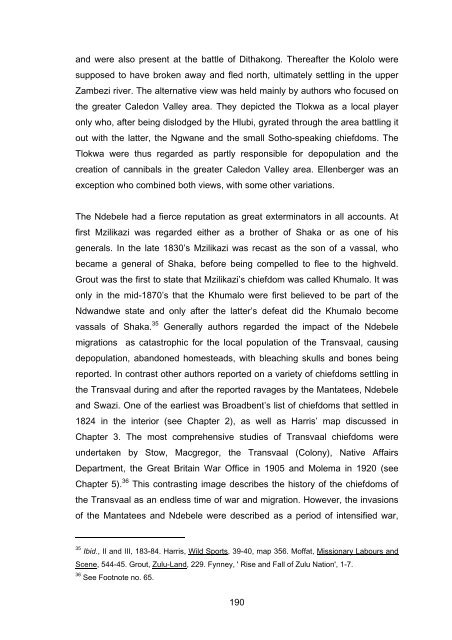The Historiographical Development of the Concept “mfecane” and ...
The Historiographical Development of the Concept “mfecane” and ...
The Historiographical Development of the Concept “mfecane” and ...
You also want an ePaper? Increase the reach of your titles
YUMPU automatically turns print PDFs into web optimized ePapers that Google loves.
<strong>and</strong> were also present at <strong>the</strong> battle <strong>of</strong> Dithakong. <strong>The</strong>reafter <strong>the</strong> Kololo were<br />
supposed to have broken away <strong>and</strong> fled north, ultimately settling in <strong>the</strong> upper<br />
Zambezi river. <strong>The</strong> alternative view was held mainly by authors who focused on<br />
<strong>the</strong> greater Caledon Valley area. <strong>The</strong>y depicted <strong>the</strong> Tlokwa as a local player<br />
only who, after being dislodged by <strong>the</strong> Hlubi, gyrated through <strong>the</strong> area battling it<br />
out with <strong>the</strong> latter, <strong>the</strong> Ngwane <strong>and</strong> <strong>the</strong> small Sotho-speaking chiefdoms. <strong>The</strong><br />
Tlokwa were thus regarded as partly responsible for depopulation <strong>and</strong> <strong>the</strong><br />
creation <strong>of</strong> cannibals in <strong>the</strong> greater Caledon Valley area. Ellenberger was an<br />
exception who combined both views, with some o<strong>the</strong>r variations.<br />
<strong>The</strong> Ndebele had a fierce reputation as great exterminators in all accounts. At<br />
first Mzilikazi was regarded ei<strong>the</strong>r as a bro<strong>the</strong>r <strong>of</strong> Shaka or as one <strong>of</strong> his<br />
generals. In <strong>the</strong> late 1830’s Mzilikazi was recast as <strong>the</strong> son <strong>of</strong> a vassal, who<br />
became a general <strong>of</strong> Shaka, before being compelled to flee to <strong>the</strong> highveld.<br />
Grout was <strong>the</strong> first to state that Mzilikazi’s chiefdom was called Khumalo. It was<br />
only in <strong>the</strong> mid-1870’s that <strong>the</strong> Khumalo were first believed to be part <strong>of</strong> <strong>the</strong><br />
Ndw<strong>and</strong>we state <strong>and</strong> only after <strong>the</strong> latter’s defeat did <strong>the</strong> Khumalo become<br />
vassals <strong>of</strong> Shaka. 35 Generally authors regarded <strong>the</strong> impact <strong>of</strong> <strong>the</strong> Ndebele<br />
migrations as catastrophic for <strong>the</strong> local population <strong>of</strong> <strong>the</strong> Transvaal, causing<br />
depopulation, ab<strong>and</strong>oned homesteads, with bleaching skulls <strong>and</strong> bones being<br />
reported. In contrast o<strong>the</strong>r authors reported on a variety <strong>of</strong> chiefdoms settling in<br />
<strong>the</strong> Transvaal during <strong>and</strong> after <strong>the</strong> reported ravages by <strong>the</strong> Mantatees, Ndebele<br />
<strong>and</strong> Swazi. One <strong>of</strong> <strong>the</strong> earliest was Broadbent’s list <strong>of</strong> chiefdoms that settled in<br />
1824 in <strong>the</strong> interior (see Chapter 2), as well as Harris’ map discussed in<br />
Chapter 3. <strong>The</strong> most comprehensive studies <strong>of</strong> Transvaal chiefdoms were<br />
undertaken by Stow, Macgregor, <strong>the</strong> Transvaal (Colony), Native Affairs<br />
Department, <strong>the</strong> Great Britain War Office in 1905 <strong>and</strong> Molema in 1920 (see<br />
Chapter 5). 36 This contrasting image describes <strong>the</strong> history <strong>of</strong> <strong>the</strong> chiefdoms <strong>of</strong><br />
<strong>the</strong> Transvaal as an endless time <strong>of</strong> war <strong>and</strong> migration. However, <strong>the</strong> invasions<br />
<strong>of</strong> <strong>the</strong> Mantatees <strong>and</strong> Ndebele were described as a period <strong>of</strong> intensified war,<br />
35 Ibid., II <strong>and</strong> III, 183-84. Harris, Wild Sports, 39-40, map 356. M<strong>of</strong>fat, Missionary Labours <strong>and</strong><br />
Scene, 544-45. Grout, Zulu-L<strong>and</strong>, 229. Fynney, ' Rise <strong>and</strong> Fall <strong>of</strong> Zulu Nation', 1-7.<br />
36 See Footnote no. 65.<br />
190

















